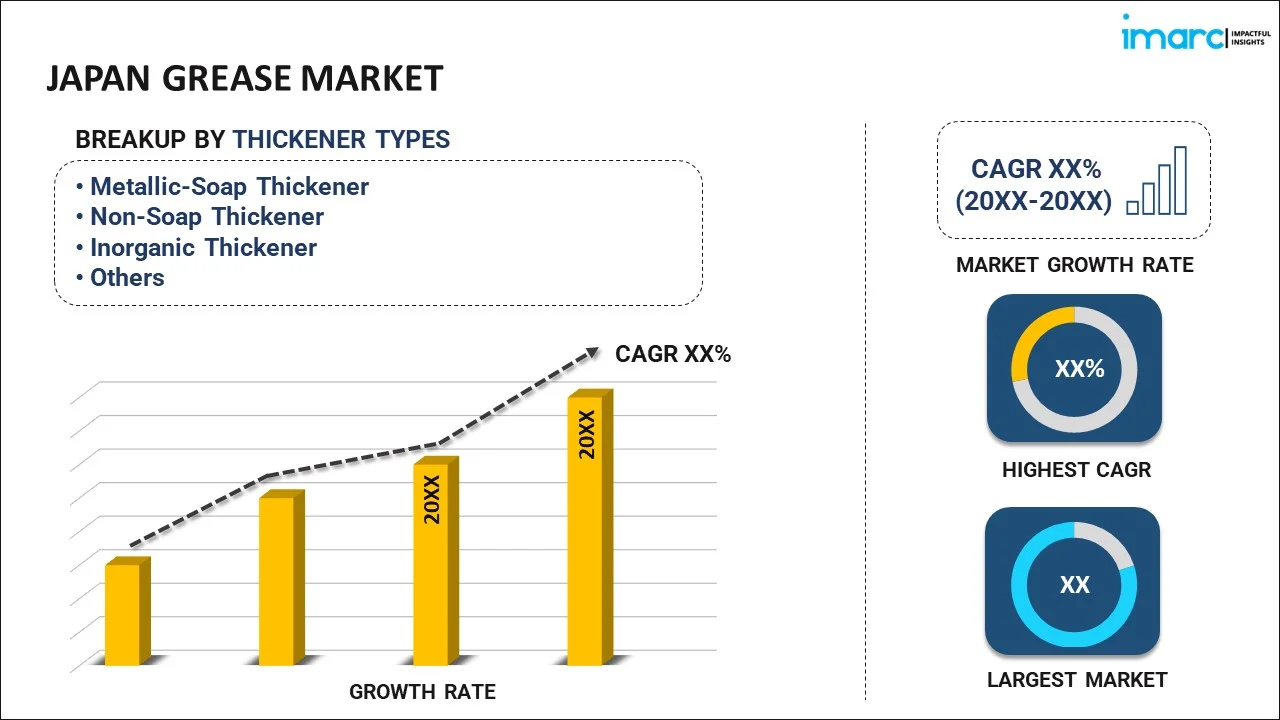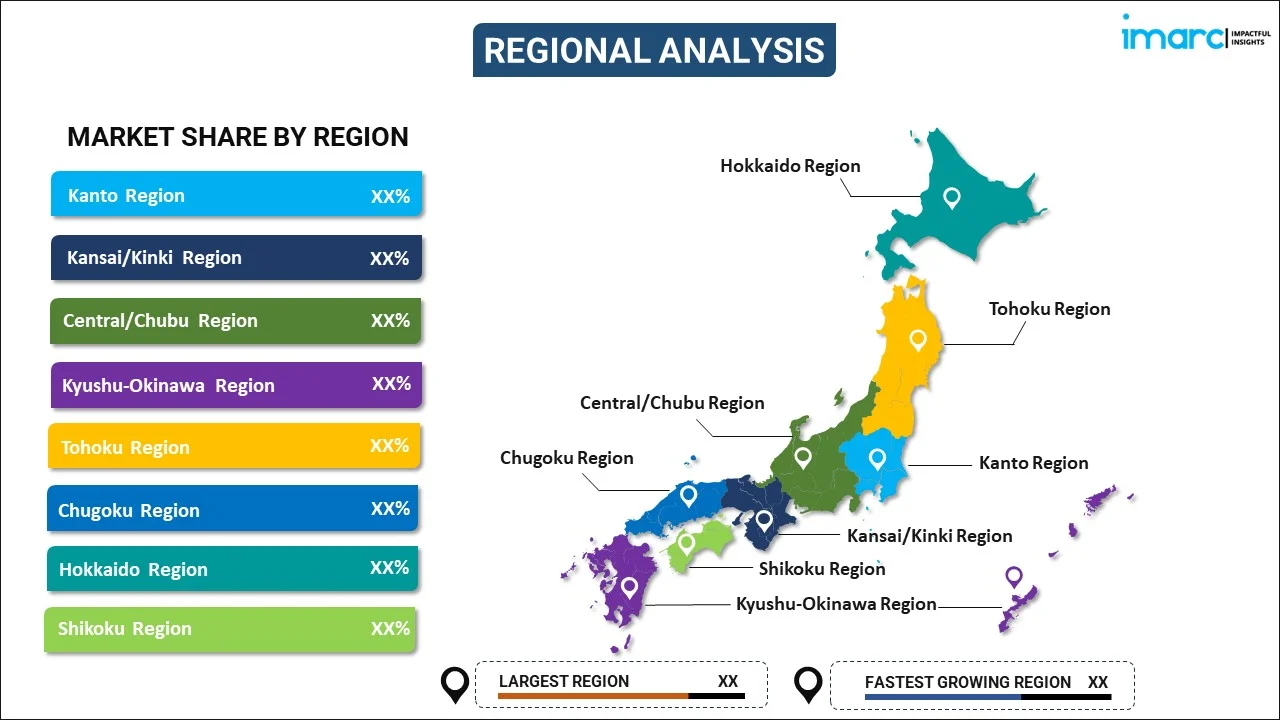
Japan Grease Market Report by Thickener Type (Metallic-Soap Thickener, Non-Soap Thickener, Inorganic Thickener, and Others), Base Oil (Mineral Oil, Synthetic Oil, Bio-based Oil), End User (Automotive, Construction and Off-Highways, General Manufacturing, Steel, Mining, and Others), and Region 2025-2033
Market Overview:
Japan grease market size reached USD 231.0 Million in 2024. Looking forward, IMARC Group expects the market to reach USD 311.0 Million by 2033, exhibiting a growth rate (CAGR) of 3.20% during 2025-2033. The increasing prevalence of infrastructure projects, such as construction, mining, and transportation, which require heavy machinery and equipment that rely on grease for smooth operation, is driving the market.
|
Report Attribute
|
Key Statistics
|
|---|---|
|
Base Year
|
2024 |
|
Forecast Years
|
2025-2033
|
|
Historical Years
|
2019-2024
|
| Market Size in 2024 | USD 231.0 Million |
| Market Forecast in 2033 | USD 311.0 Million |
| Market Growth Rate (2025-2033) | 3.20% |
Grease is a versatile, semi-solid lubricant employed to safeguard a wide range of equipment, including vessels, machinery, vehicles, and their components, against the damaging effects of corrosion and wear. This substance is composed of a mixture of performance-improving additives, lubricating fluids, and thickeners. Its production involves the use of rendered fat from waste animal parts, inedible lard, synthetic oil, or petroleum-derived ingredients blended with a thickening agent. One of the key functions of grease is to act as a protective sealant, preventing water infiltration and safeguarding against contaminants. Furthermore, it plays a crucial role in maintaining flexibility, preserving the integrity of bearing surfaces, optimizing stop-and-start performance, and reducing friction. Grease also offers notable advantages, including exceptional thermal stability, resistance to wear, superior rust-proofing capabilities, a high viscosity index, and effective corrosion protection. Due to these remarkable properties, grease has found widespread applications across diverse industries, such as automotive, chemical manufacturing, power generation, metallurgy, and the food and beverage sector.
Japan Grease Market Trends:
The grease market in Japan is influenced by a multitude of factors that drive its growth and evolution. To begin with, the automotive industry plays a pivotal role in propelling the demand for grease. As more vehicles hit the roads, the need for lubricants to ensure the smooth operation of engines, gears, and bearings becomes increasingly apparent. Moreover, the expansion of the industrial sector further fuels the grease market. Industries rely heavily on lubrication to maintain the efficiency and durability of machinery, a fact that directly contributes to the market's expansion. Furthermore, technological advancements are another crucial driver of the grease market. As machinery becomes more sophisticated and precise, the demand for specialized and high-performance greases rises. These innovations cater to various industries, including aerospace, renewable energy, and manufacturing, fostering the growth of the market. Additionally, the growing emphasis on sustainability and environmental responsibility, along with the regional shift towards greener alternatives that has led to the development of eco-friendly greases, is expected to drive the grease market in Japan during the forecast period.
Japan Grease Market Segmentation:
IMARC Group provides an analysis of the key trends in each segment of the market, along with forecasts at the country level for 2025-2033. Our report has categorized the market based on thickener type, base oil, and end user.
Thickener Type Insights:

- Metallic-Soap Thickener
- Non-Soap Thickener
- Inorganic Thickener
- Others
The report has provided a detailed breakup and analysis of the market based on the thickener type. This includes metallic-soap thickener, non-soap thickener, inorganic thickener, and others.
Base Oil Insights:
- Mineral Oil
- Synthetic Oil
- Bio-based Oil
A detailed breakup and analysis of the market based on the base oil have also been provided in the report. This includes mineral oil, synthetic oil, and bio-based oil.
End User Insights:
- Automotive
- Construction and Off-Highways
- General Manufacturing
- Steel
- Mining
- Others
The report has provided a detailed breakup and analysis of the market based on the end user. This includes automotive, construction and off-highways, general manufacturing, steel, mining, and others.
Regional Insights:

- Kanto Region
- Kansai/Kinki Region
- Central/ Chubu Region
- Kyushu-Okinawa Region
- Tohoku Region
- Chugoku Region
- Hokkaido Region
- Shikoku Region
The report has also provided a comprehensive analysis of all the major regional markets, which include Kanto Region, Kansai/Kinki Region, Central/ Chubu Region, Kyushu-Okinawa Region, Tohoku Region, Chugoku Region, Hokkaido Region, and Shikoku Region.
Competitive Landscape:
The market research report has also provided a comprehensive analysis of the competitive landscape. Competitive analysis such as market structure, key player positioning, top winning strategies, competitive dashboard, and company evaluation quadrant has been covered in the report. Also, detailed profiles of all major companies have been provided. Some of the key players include:
- ENEOS Corporation (ENEOS Holdings)
- Fuchs Japan Ltd.
- Idemitsu Kosan Co. Ltd.
- IWASAKI Corporation
- Kyodo Yushi Co. Ltd.
(Please note that this is only a partial list of the key players, and the complete list is provided in the report.)
Japan Grease Market Report Coverage:
| Report Features | Details |
|---|---|
| Base Year of the Analysis | 2024 |
| Historical Period | 2019-2024 |
| Forecast Period | 2025-2033 |
| Units | Million USD |
| Scope of the Report | Exploration of Historical and Forecast Trends, Industry Catalysts and Challenges, Segment-Wise Historical and Predictive Market Assessment:
|
| Thickener Types Covered | Metallic-Soap Thickener, Non-Soap Thickener, Inorganic Thickener, Others |
| Base Oils Covered | Mineral Oil, Synthetic Oil, Bio-based Oil |
| End Users Covered | Automotive, Construction and Off-Highways, General Manufacturing, Steel, Mining, Others |
| Regions Covered | Kanto Region, Kansai/Kinki Region, Central/ Chubu Region, Kyushu-Okinawa Region, Tohoku Region, Chugoku Region, Hokkaido Region, Shikoku Region |
| Companies Covered | ENEOS Corporation (ENEOS Holdings), Fuchs Japan Ltd., Idemitsu Kosan Co. Ltd., IWASAKI Corporation, Kyodo Yushi Co. Ltd., etc. |
| Customization Scope | 10% Free Customization |
| Post-Sale Analyst Support | 10-12 Weeks |
| Delivery Format | PDF and Excel through Email (We can also provide the editable version of the report in PPT/Word format on special request) |
Key Questions Answered in This Report:
- How has the Japan grease market performed so far and how will it perform in the coming years?
- What has been the impact of COVID-19 on the Japan grease market?
- What is the breakup of the Japan grease market on the basis of thickener type?
- What is the breakup of the Japan grease market on the basis of base oil?
- What is the breakup of the Japan grease market on the basis of end user?
- What are the various stages in the value chain of the Japan grease market?
- What are the key driving factors and challenges in the Japan grease?
- What is the structure of the Japan grease market and who are the key players?
- What is the degree of competition in the Japan grease market?
Key Benefits for Stakeholders:
- IMARC’s industry report offers a comprehensive quantitative analysis of various market segments, historical and current market trends, market forecasts, and dynamics of the Japan grease market from 2019-2033.
- The research report provides the latest information on the market drivers, challenges, and opportunities in the Japan grease market.
- Porter's five forces analysis assist stakeholders in assessing the impact of new entrants, competitive rivalry, supplier power, buyer power, and the threat of substitution. It helps stakeholders to analyze the level of competition within the Japan grease industry and its attractiveness.
- Competitive landscape allows stakeholders to understand their competitive environment and provides an insight into the current positions of key players in the market.
Need more help?
- Speak to our experienced analysts for insights on the current market scenarios.
- Include additional segments and countries to customize the report as per your requirement.
- Gain an unparalleled competitive advantage in your domain by understanding how to utilize the report and positively impacting your operations and revenue.
- For further assistance, please connect with our analysts.
 Inquire Before Buying
Inquire Before Buying
 Speak to an Analyst
Speak to an Analyst
 Request Brochure
Request Brochure
 Request Customization
Request Customization




.webp)




.webp)












